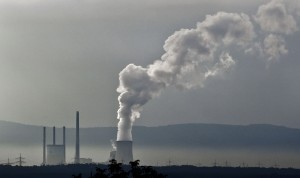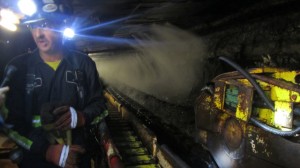How Will EPA’s New Carbon Limits Impact Coal In PA?
-
Katie Colaneri
When it comes to energy in Pennsylvania, it may seem like it’s all about natural gas, right? In fact, coal is still one of the state’s main sources of electricity, but that’s starting to change.
Now the Obama administration is proposing new rules to cut carbon emissions for all future coal-fired power plants which proponents of coal say is a direct threat to the survival of the industry.
The Washington Post’s Wonkblog has a great primer on the new rules:
To get more specific: All future coal plants will need to emit no more than 1,100 pounds of carbon dioxide per megawatt-hour. That’s well below the current U.S. coal plant average of 1,768 pounds of carbon dioxide per megawatt-hour.
All new large natural gas-fired plants, meanwhile (roughly 100MW or larger), would be restricted to 1,000 pounds of carbon dioxide per megawatt-hour. Smaller gas turbines, which typically less inefficient and used less frequently, will be limited to 1,100 pounds. Natural gas shouldn’t have too much trouble here: Modern combined-cycle gas plants can already meet this standard.
There’s also some flexibility built in. Coal plants can phase in the limits over a seven-year period as long as they average 1,050 pounds of carbon-dioxide per megawatt-hour over that period. The idea is that utilities can have some time to install stricter emissions controls.
Most natural gas-fired plants are expected to easily meet these new standards. But in order to get the necessary permits from the Environmental Protection Agency, all new coal plants would need to use something called “carbon capture and sequestration technology” or CCS to bury most of their carbon emissions underground.
‘A De Facto Ban’ On Coal-Fired Electricity
Carbon capture technology is still being developed and it’s very expensive. That’s why some Pennsylvania lawmakers and coal boosters are calling the new rules a ban, or even a “war on coal.”
“They have now put a standard for new power plant generation that is not commercially available,” says John Pippy, CEO of the Pennsylvania Coal Alliance.
“We need to have a standard that is achievable, but that would also inspire more clean coal technology. But if you give us a standard that is a de facto ban, you won’t see that future investment.”
But Adam Riedel, an environmental attorney with a Washington, D.C.-based firm, says the Obama administration could be trying to force the coal industry to develop CCS technology.
He compares it to some of the first vehicle emissions standards issued in the 1970s that forced the auto industry to develop the catalytic converter, a pollution-control device that is still used in most cars’ exhaust systems.
Riedel acknowledges that power generation may be a different story. Cars in the 1970s had no other way of meeting those standards without coming up with a way to deal with exhaust from tailpipes.
“Because of the domestic abundance and the very, very low prices of natural gas right now, there’s a chance that utilities say, rather than pursue investment in carbon capture and sequestration, that it’s more economical to just switch to natural gas,” Riedel says.
Pennsylvania did try its hand at CCS development under the Rendell administration. In 2009, the Department of Conservation and Natural Resources teamed up with the Clinton Foundation and six power plants across the state to study it. The DCNR released two studies in 2010, which have since been removed from the state’s website.
Former DCNR secretary John Quigley says the administration ran out of time, but the biggest hurdle was coming up with a way to patch together public and private land to store all of the carbon underground. Quigley is heartened by the EPA’s new rules.
“To really incentivize CCS, you need aggressive regulations,” Quigley says. “This should require CCS for natural gas plants, too.”
Competition from Natural Gas
There aren’t many new coal-fired power plants being proposed, so it is unlikely that the new rules will force the development of new carbon capture technology or have much impact on America’s greenhouse gas emissions.

Frank Rumpenhorst DPA /LANDOV
A 2009 state report found Pennsylvania contributes one percent of the world’s greenhouse gases.
But the new rules are only the first step in Obama’s plan to tackle climate change. Pippy with the Pennsylvania Coal Alliance is most worried about what’s coming next.
“If you prohibit the creation of the new coal power plant by demanding technology that’s not commercially available and then next year, you come back with a standard that says you need to retrofit, retrofit won’t occur,” Pippy says. “What will occur is premature retirement and when those plants retire then you’re going to see skyrocketing costs of energy as well as a tremendous impact on the jobs.”
If that happens, Pippy says more coal-fired power plants will shut down which has already started happening in Pennsylvania. Eight of the state’s coal plants are getting ready to close. Last week, Reuters reported 380 people will lose their jobs when the Hatfield’s Ferry and Mitchell power plants shut down early next month, citing the cost of complying with emissions standards and the nationwide move to natural gas-fired electricity.
Matt Walker with the Clean Air Council is looking forward to seeing the administration’s regulations on existing power plants. He says the new rules for future plants are a good first step.
“It’ll greatly cut the pollution that drives climate change and reduce impacts on public health.”
But even Walker calls carbon capture technology “a pipe dream.”
“It’s really expensive, it hasn’t been really proven yet and the amount of time, infrastructure, money spent on doing that could be much better spent on focusing on renewable energy than on coal.”
What’s next for coal?
So where does this leave the coal industry? Obama administration officials continue to insist coal will not be left out of America’s energy equation, but that’s not how guys like John Pippy see it.
He says if the administration was serious about reducing emissions and keeping jobs for citizens, it would fine tune the rules to help replace some of Pennsylvania’s decades-old coal-fired power plants with commercially viable technology.
“If we don’t continuously replace the older plants with newer plants, then we are going to have significant problems down the road.”

















